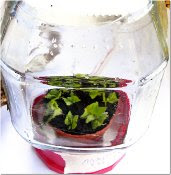 Watering with 'Systhane' at normal strength does not seem to have worked on the triphylla fuchsia I treated last week.
Watering with 'Systhane' at normal strength does not seem to have worked on the triphylla fuchsia I treated last week.The botrytis seems to be reviving in the freshly-dampened compost. It also seems to have survived on other cuttings of fuchsias, as well; the fungus has been restricted but not apparently killed. I don't know if a stronger dose would do the trick.
TIME OF APPLICATION MIGHT BE CRITICAL
Synthetic fungicides are usually curative in action (and can also be preventative, as well, if applied before infection), so they should work on the mature fungal body (mycelium) and not just the spores. They attack the fungus metabolism at a particular - and usually very specific - stage.
So application at the right stage is essential. (Myclobutanil, the active ingredient of 'Systhane', works by inhibiting the biosynthesis of sterols (enzymes used by fungus) in fungal membranes). Nevertheless, I would expect sterol inhibiting to be effective at any stage. However, to be fair, there was never any claim that 'Systhane' is effective against this disease. But here's something strange:
 These young fuchsia cuttings are completely free from botrytis, yet they are sealed in a cool (10 - 12 deg C) damp propagator (inverted 200 gram Coffee Jar), and have been for two weeks. Surely these are ideal conditions for botrytis? Why aren't they infected? I don't know. But I'll wager it has something to do with first spraying the cuttings and compost with 'Systhane'.
These young fuchsia cuttings are completely free from botrytis, yet they are sealed in a cool (10 - 12 deg C) damp propagator (inverted 200 gram Coffee Jar), and have been for two weeks. Surely these are ideal conditions for botrytis? Why aren't they infected? I don't know. But I'll wager it has something to do with first spraying the cuttings and compost with 'Systhane'.MORE PROBLEMS
 And there's another problem: The damage to these leaves (these are the cuttings you saw last week) has only occurred since I used 'Systhane'. Yet the cuttings in the propagator have not been damaged. Why is this?
And there's another problem: The damage to these leaves (these are the cuttings you saw last week) has only occurred since I used 'Systhane'. Yet the cuttings in the propagator have not been damaged. Why is this?Of course, it could be that the damage is not caused by 'Systhane'. However, I think it more likely that damage only occurs when the treated leaves are allowed to dry.
DO NOT USE 'SYSTHANE' ON YOUNG FUCHSIAS
The instructions on the bottle did advise against using 'Systhane' on young fuchsias. So no point complaining too much.
No comments:
Post a Comment